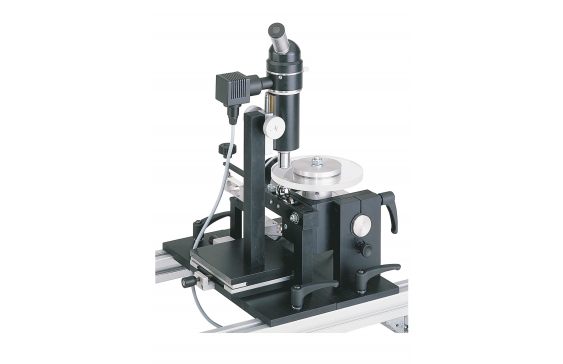TM 260.02 Elasto-hydrodynamic behaviour

Elasto-hydrodynamic lubrication occurs in roller bearings, gear wheels and cam followers, whose contact surfaces are subjected to high loads. These surfaces are elastically deformed because of high contact pressures. The theory of elasto-hydrodynamics (EHD theory) takes into consideration the elastic deformation of the bodies in contact with each other and provides a basis for calculating the influence of lubrication on damage to gears and roller bearings.
The tribological system in TM 260.02 allows a clear representation of the elasto-hydrodynamic behaviour of lubricating film layers.
To do this, the lubricating film between a sphere and a glass plate is determined and studied using a reflected-light microscope. The experimental unit contains a rotating glass plate and a steel sphere as the friction pair. The steel sphere is pressed against the glass plate from underneath. The contact force between the friction partners can be adjusted continuously by means of a lever. A lubricating film is located between the sphere and glass plate at the contact point. The glass plate is plane-parallel and dielectric coated. The surface of the hardened steel ball is polished. The reflected-light microscope stands on an adjustable xy cross table and has a focus drive.
The TM 260 drive unit is required in order to conduct experiments. The experimental unit is mounted quickly and easily on the frame of the drive unit with quick-action chucks.
The glass plate is driven by a clampable coupling between drive unit and gear unit. The display and control unit of the drive unit shows contact force and speed and allows the continuous adjustment of the speed.
In the experiment, light waves from the reflected-light microscope pass through the glass plate and the lubricating film and are reflected by the surface of the steel sphere. The light waves are refracted in the lubricating film, making colour interference fringes visible. The wavelength of light increases or decreases with the variable thickness of the lubricating film. The thickness of the lubricating film is determined visually by means of the colour of the interference fringes created. The contact force is measured by a force sensor.
- elasto-hydrodynamic behaviour between the sphere and rotating-glass-plate friction pair
- investigation of the thickness and shape of the lubricating film
Load application device
- max. load: 150N
- lever arm ratio: 3:1
Sphere
- diameter: 25,4mm
- hardened steel, polished
Glass plate
- diameter: 150mm, plane-parallel
- coating: BK 7, dielectric, R=30%
Microscope
- magnification: x50
- halogen lamp: 10W
Force sensor: 0…50N
- elasto-hydrodynamic behaviour of a lubricating film layer between sphere and rotating glass plate
- quick and easy assembly of the experimental unit on the frame of the drive unit
- determine the thickness of the lubricating film by optical interference
- glass plate is driven by a clampable coupling between drive unit and gear unit
- hardened steel sphere, polished
- rotating plane-parallel glass plate with dielectric coating
- continuous load on the sphere via lever arm
- load measured by force sensor
- displays of force and speed and speed adjustment on the drive unit
together with the drive unit
- determine the thickness of the lubricating film at the contact point of a sphere with a plane surface – compare with theoretical value
- study the effect of load and speed on the thickness of the lubricating film
